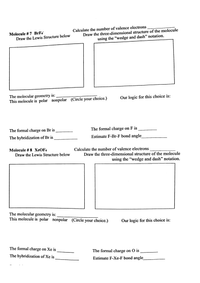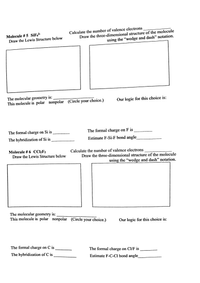
Chemistry
10th Edition
ISBN: 9781305957404
Author: Steven S. Zumdahl, Susan A. Zumdahl, Donald J. DeCoste
Publisher: Cengage Learning
expand_more
expand_more
format_list_bulleted
Concept explainers
Question

Transcribed Image Text:Calculate the number of valence electrons
Draw the three-dimensional structure of the molecule
Molecule # 7 BrF4
Draw the Lewis Structure below
using the "wedge and dash" notation.
The molecular geometry is:
This molecule is polar nonpolar (Circle your choice.)
Our logic for this choice is:
The formal charge on Br is
The formal charge on F is
The hybridization of Br is
Estimate F-Br-F bond angle
Molecule #3 8 ХеOF4
Draw the Lewis Structure below
Calculate the number of valence electrons
Draw the three-dimensional structure of the molecule
using the "wedge and dash" notation.
The molecular geometry is:
This molecule is polar nonpolar (Circle your choice.)
Our logic for this choice is:
The formal charge on Xe is
The formal charge on O is
The hybridization of Xe is
Estimate F-Xe-F bond angle

Transcribed Image Text:Calculate the number of valence electrons
Molecule # 5 SiF?-
Draw the Lewis Structure below
Draw the three-dimensional structure of the molecule
using the "wedge and dash" notation.
The molecular geometry is:
This molecule is polar nonpolar (Circle your choice.)
Our logic for this choice is:
The formal charge on Si is
The formal charge on F is
The hybridization of Si is
Estimate F-Si-F bond angle
Molecule # 6 CC2F2
Draw the Lewis Structure below
Calculate the number of valence electrons
Draw the three-dimensional structure of the molecule
using the "wedge and dash" notation.
The molecular geometry is:
This molecule is polar nonpolar (Circle your choice.)
Our logic for this choice is:
The formal charge on C is
The formal charge on Cl/F is
The hybridization of C is
Estimate F-C-Cl bond angle
Expert Solution
This question has been solved!
Explore an expertly crafted, step-by-step solution for a thorough understanding of key concepts.
This is a popular solution
Trending nowThis is a popular solution!
Step by stepSolved in 4 steps with 2 images

Knowledge Booster
Learn more about
Need a deep-dive on the concept behind this application? Look no further. Learn more about this topic, chemistry and related others by exploring similar questions and additional content below.Similar questions
- Identify Element A Identify Element B Identify the compund formula Using electronegativities, show which type of bond is present. Is the molecule polar, yes or no? What 3D shape does this molecule have? What are the bond angles in this shape?arrow_forwardFor the following molecules, sketch the three dimensional shape, describe the molecular geometry of each central atom, and describe bond angles around each central atom. HClO3 (the hydrogen is bonded to an oxygen) CH3NH2arrow_forwardUse the following information to determine the Lewis structure, find the electron and molecular geometry of the molecule, determine the angle of the molecule, and determine the polarity. If the atoms are not the same, you may assume that the difference in their electronegativities are between 0.4 and 2.0. Atom information: A: 6 valence electrons, CAN exceed the octet. Further from fluorine on the periodic table than X. X: 6 valence electrons, CANNOT exceed the octet. Closer to fluorine on the periodic table than A. Molecule: AX2 Electron Geometry: [Select 1 Molecular Geometry: I Select ] Bond Angle: [ Select] Polarity: [ Select]arrow_forward
- Need help on this questionarrow_forwardWhich statements about resonance are correct? Select all that apply When drawing resonance structures, it is okay to move atoms around as needed. New formal charges can be created when doing resonance, so long as the overall charge of the molecule is the same in all structures. • Hybridization of atoms can change when involved in electron movement Sigma bonds cannot be messed with in resonance Resonance occurs because it helps stabilize molecules ●arrow_forward- Complete the table. Number of electron groups Bond angle Outer atoms/Lone pairs 2 ? 2/0 3 4 ? ? bond angle in a two electron group molecule: bond angle in a three electron group molecule: bond angle in a four electron group molecule: 3/0 2/1 4/0 3/1 2/2 Shape ? trigonal planar (planar triangular) ? tetrahedral ? bent The shape of a two electron group molecule is The shape of a three electron group molecule with two outer atoms and one lone pair is The shape of a four electron group molecule with three outer atoms and one lone pair isarrow_forward
- Use the following information to determine the Lewis structure, find the electron and molecular geometry of the molecule, determine the angle of the molecule, and determine the polarity. If the atoms are not the same, you may assume that the difference in their electronegativities are between 0.4 and 2.0. Atom information: A: 8 valence electrons, CAN exceed the octet. Further from fluorine on the periodic table than X. X: 7 valence electrons, CANNOT exceed the octet. Closer to fluorine on the periodic table than A. Molecule: AX4 Electron Geometry: [Select] Molecular Geometry: [Select] Bond Angle: [ Select ] Polarity: [ Select ]arrow_forwardI keep getting these questions wrongarrow_forwardPlease answer all parts of the questionarrow_forward
- Draw three resonance structures for N3-. This species has its three atoms bonded sequentially in the following fashion: N-N-N. Draw your resonance structures so that the atoms in them are bonded together in this order. Select the most important resonance structure for this species based on the formal charges on the atoms of the three resonance structures you have drawn. Now select the statement from the multiple choices which is true about this most important resonance structure.In the most important resonance structure of N3- : a) The leftmost bond (between N and N) is a single bond.b) The rightmost bond (between N and N) is a single bond.c) The formal charge on the leftmost (N) atom is -1.d) The number of nonbonding pairs (lone pairs) of electrons on the leftmost (N) atom is 4.e) The number of nonbonding (lone) pairs of electrons on the rightmost (N) atom is 4.arrow_forwardA Lewis structure is a two-dimensional representation of a molecule that does not necessarily show what shape that molecule would take in three dimensions. Based on the Lewis structure and your knowledge of VSEPR theory, approximate the smallest bond angle in this molecule. XÿX smallest bond angle: Oarrow_forwardDetermine the number of electron groups around the central atom for each of the following molecules. OF2arrow_forward
arrow_back_ios
SEE MORE QUESTIONS
arrow_forward_ios
Recommended textbooks for you
 ChemistryChemistryISBN:9781305957404Author:Steven S. Zumdahl, Susan A. Zumdahl, Donald J. DeCostePublisher:Cengage Learning
ChemistryChemistryISBN:9781305957404Author:Steven S. Zumdahl, Susan A. Zumdahl, Donald J. DeCostePublisher:Cengage Learning ChemistryChemistryISBN:9781259911156Author:Raymond Chang Dr., Jason Overby ProfessorPublisher:McGraw-Hill Education
ChemistryChemistryISBN:9781259911156Author:Raymond Chang Dr., Jason Overby ProfessorPublisher:McGraw-Hill Education Principles of Instrumental AnalysisChemistryISBN:9781305577213Author:Douglas A. Skoog, F. James Holler, Stanley R. CrouchPublisher:Cengage Learning
Principles of Instrumental AnalysisChemistryISBN:9781305577213Author:Douglas A. Skoog, F. James Holler, Stanley R. CrouchPublisher:Cengage Learning Organic ChemistryChemistryISBN:9780078021558Author:Janice Gorzynski Smith Dr.Publisher:McGraw-Hill Education
Organic ChemistryChemistryISBN:9780078021558Author:Janice Gorzynski Smith Dr.Publisher:McGraw-Hill Education Chemistry: Principles and ReactionsChemistryISBN:9781305079373Author:William L. Masterton, Cecile N. HurleyPublisher:Cengage Learning
Chemistry: Principles and ReactionsChemistryISBN:9781305079373Author:William L. Masterton, Cecile N. HurleyPublisher:Cengage Learning Elementary Principles of Chemical Processes, Bind...ChemistryISBN:9781118431221Author:Richard M. Felder, Ronald W. Rousseau, Lisa G. BullardPublisher:WILEY
Elementary Principles of Chemical Processes, Bind...ChemistryISBN:9781118431221Author:Richard M. Felder, Ronald W. Rousseau, Lisa G. BullardPublisher:WILEY

Chemistry
Chemistry
ISBN:9781305957404
Author:Steven S. Zumdahl, Susan A. Zumdahl, Donald J. DeCoste
Publisher:Cengage Learning

Chemistry
Chemistry
ISBN:9781259911156
Author:Raymond Chang Dr., Jason Overby Professor
Publisher:McGraw-Hill Education

Principles of Instrumental Analysis
Chemistry
ISBN:9781305577213
Author:Douglas A. Skoog, F. James Holler, Stanley R. Crouch
Publisher:Cengage Learning

Organic Chemistry
Chemistry
ISBN:9780078021558
Author:Janice Gorzynski Smith Dr.
Publisher:McGraw-Hill Education

Chemistry: Principles and Reactions
Chemistry
ISBN:9781305079373
Author:William L. Masterton, Cecile N. Hurley
Publisher:Cengage Learning

Elementary Principles of Chemical Processes, Bind...
Chemistry
ISBN:9781118431221
Author:Richard M. Felder, Ronald W. Rousseau, Lisa G. Bullard
Publisher:WILEY